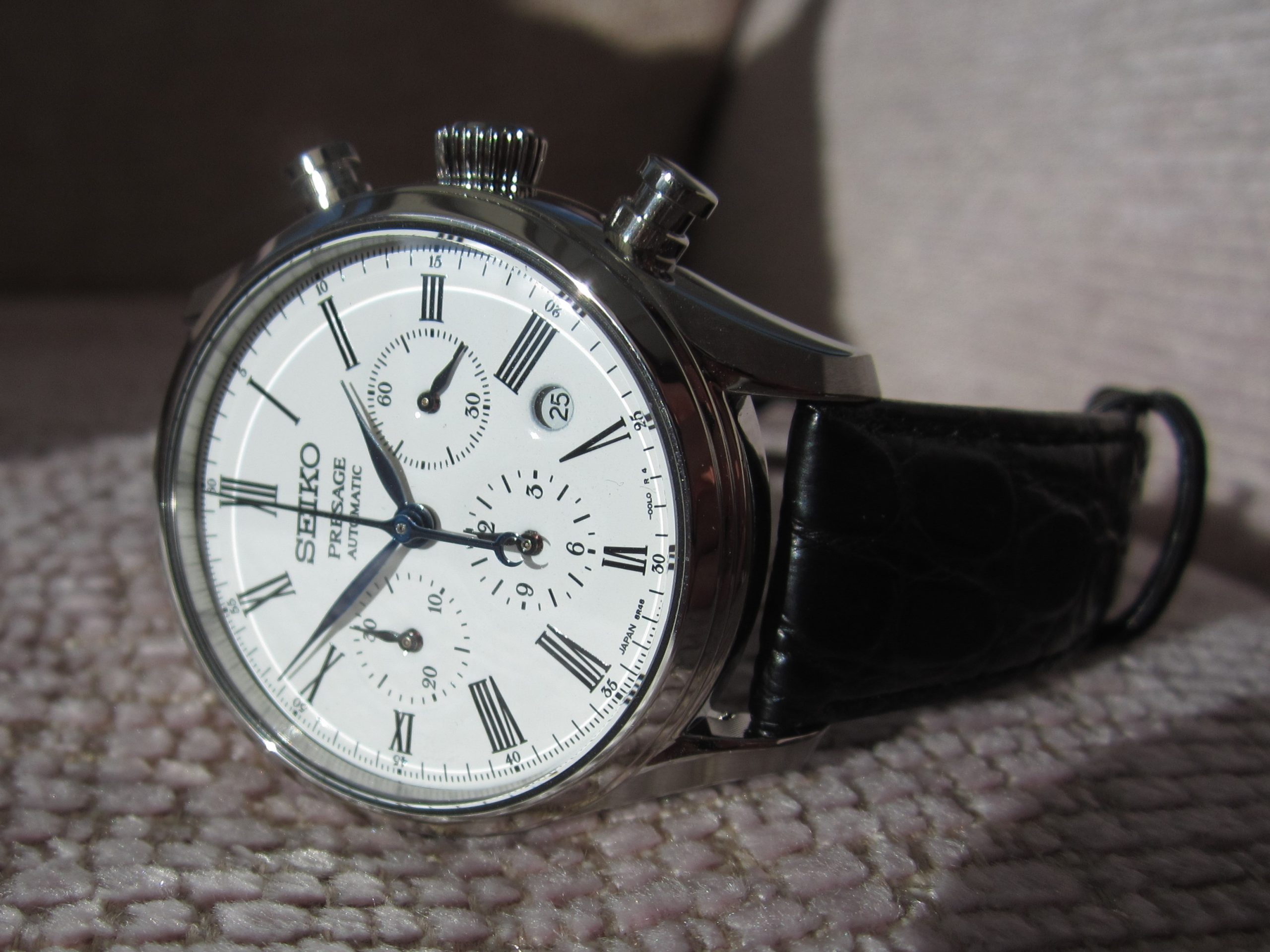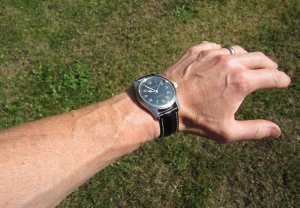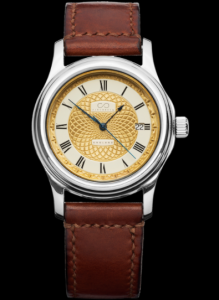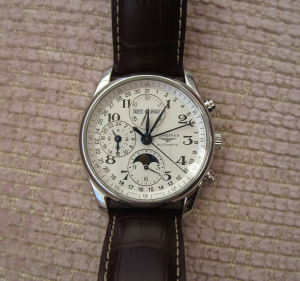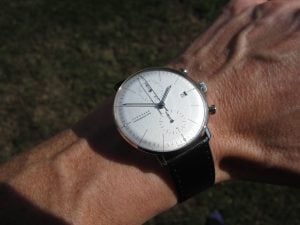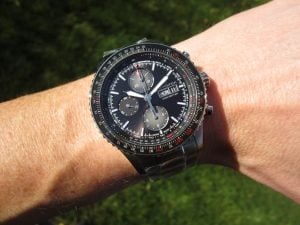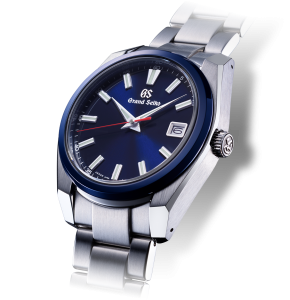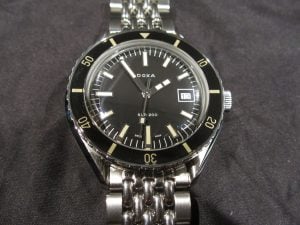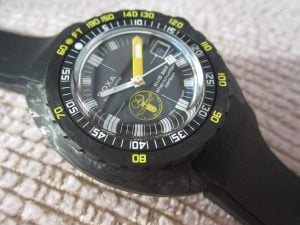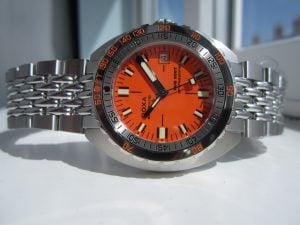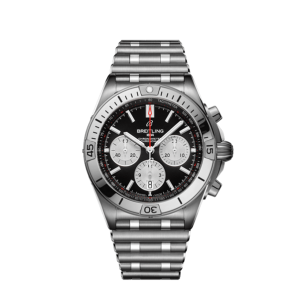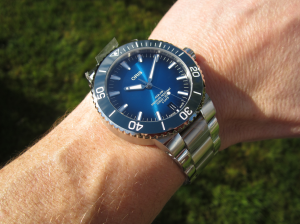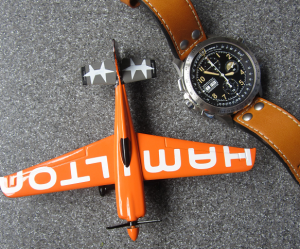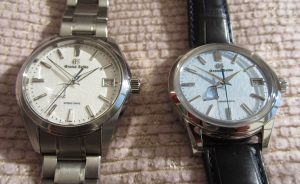The Seiko SRQ023J1, and a history of the best value chronograph movement ever.
As an introduction to the glorious Seiko SRQ023J1 I believe it prudent to visit the pantheon of Seiko’s mechanical chronograph movements:
The monopusher calibre 5719 powered Japan’s first chronograph wrist watch in 1964. This was released to commemorate Seiko’s timing responsibilities at the Tokyo Olympics of the same year. An exceptional reinterpretation was released last year to mark its 55th anniversary: https://amjwatches.co.uk/seiko-presage-55th-anniversary-limited-edition-srq031j1.html
The calibre 5718 followed with separate start-stop and reset buttons and an integer counter within the aperture at 12 O’clock. The buttons on the left side of the case count up or down. Primarily designed for keeping tally of your golf strokes, this rare complication can be utilised to record any total you desire.
The calibre 6139 is, undoubtedly, one of the most famous chronograph movements of all time as it became (despite what Zenith, Breitling, Tag Heuer, Hamilton and Bruen claiming the contrary) the first ever automatic chronograph on the market in May 1969.
Interestingly, Seiko were producing the 6139 as far back as January 1969. There are a very few examples that sometimes turn up at auction. If you want a truly grail Seiko keep a look out for one of the January ones. February and March production are also very covetable in the Seiko collecting fraternity. This incredible day-date chronograph movement set the benchmark straight away with its column wheel, vertical coupling chronograph and patented magic lever winding system. This movement can also claim to be the first ever self-winding chronograph in space when William Pogue wore one during the Skylab-4 mission in 1973. The “Seiko Pogue” is an aspirational acquisition for all Seiko fans, hence why I own one, proudly shown below.
Calibre 6138 closely followed in 1970 and incorporated a running seconds hand and a 12 hour counter. This was most famously used in the Seiko “Bullhead”.
Also during 1970, Seiko released the 7017 chronograph which was just 5.9mm thick and set a world record at the time.
Due to its own success with the quartz chronograph movement (of which it also created the first ever) and the LCD multifunction wrist watch ( which, you guessed it, they released the world’s first) Seiko ceased production of mechanical movements in 1980.
It wasn’t until the 1998 would Seiko commence manufacturing mechanical chronographs again with the fantastic 6S series. Not only was this movement used in the pinnacle of their brands Credor, but it was also used by other high-end brands and was also the basis for Tag Heuer’s “in-house” calibre 1887.
The Tag Heuer 1887 movement was based on Seiko’s blueprints (courtesy of tagheuer.com)
Which leads us to the 8R chronographs in use today and the superb engine for the SRQ023J1 showcased here and more of which later.
The fundamental purpose of a chronograph (time writer) is to record the given period for any episode. Seiko’s rich history of being relied upon to time the most important sporting events include their involvement with the World Cup, Olympic Games, official timer for the IAAF which commenced in 1985, Pan Pacific Swimming Championships, Nagano Winter Olympics and the Tokyo Marathon, to name a few. Along the way the tireless boffins at Seiko have created the False Start Detection System (1984), Electronic Distance Measurement (EDM) equipment (1987), the Split Video with Ultrasonic Anemometer (1991) and the Road Race Transponder (1999) plus they have made huge leaps in the development of the Electronic Start Pistol, Start Block Pressure Pads, the False Start Detection System, the Photo Finish Camera, the Video Distance Measurement system, the Ultrasonic Wind Gauge and the Photo Beam Unit.
Seiko were official timers for the 1978, 1982, 1986 and 1990 World Cups
Seiko were official timing partners at the 1964 Tokyo Olympics
Seiko continue to be the official timing partners for the IAAF
Seiko at the Pan Pacific Swimming Championships in 1997
Seiko timing the Tokyo Marathon
Specification
I never consider myself a megalomaniac, but I do love to control time. The act of starting and stopping time via a nicely weighted pushbutton, that triggers the silent rotational motion of the seconds hand is what makes the chronograph my favourite of all the horological complications. This harmless form of manipulation is further enhanced if your chronograph is both beautiful to behold, a pleasure to operate and is manufactured by one of the greatest producers of stopwatch movements ever. Enter the SRQ023J1 powered by the extraordinary 8R48 movement.
This typically over-engineered workhorse that has been designed, developed and manufactured by Seiko contains 34 jewels, has a 45 hour power reserve and runs at 28,800 vph. Incidentally, the moniker “manufacture” may seem less relevant to some brands, who still buy in a lot of the internal and external componentry, but for Seiko it is all encompassing. They make their own sapphire glass, their own anti-reflective coating, their own springs, their own screws, their own cases, etc, etc. You name it, they produce it.
The 8R48 movement also benefits from the column wheel, at once loved by watchmakers and fans but disliked by the accountants. The most prevalent component for actuation of a chronograph is a double cam, whilst the reset operation is based on a simple heart-shaped cam. The secondary function of the former prevents accidental operation of the latter, which would be potentially fatal to the movement. This simple to manufacture part is ubiquitous purely based on its cost effectiveness. Whilst being a reliable way of initiating and resetting the stopwatch, the major draw-back is that it lacks precision, in both starting and resetting, and also feedback to the user. The more expensive solution to all these maladies is the column wheel. This structural component takes on the appearance of a castle turret and assures instant and accurate inauguration of the given operations. In basic terms the column wheel is a precision digital solution to the vague analogue cam. Because of this accurate deployment and detachment of the column wheel the pushers have a much-improved resistive feel. As a chronograph junky (I’ll record everything from how long my cup of tea takes to be drinkable without scolding me ,12 minutes, to how long the infuriating temporary traffic light system holds you for no obvious reason on the bridge leaving our village, 3 minutes 32 seconds) I feel strategically positioned to state that the tactile interface of the 8R48 pushers is as good as I have utilised. Furthermore, the triumphant 8R48 movements offers a stutter-free, precise chronograph start and a flawless reset that is faster than the human eye can witness.
Having a column wheel chronograph in your horological arsenal puts you in an elitist group. It is now not uncommon for manufactures to, rightfully, show off their watch making superiority by having the column wheel clearly on display, even colouring it in some instances. For example, the Tag Heuer Calibre 02 manufacture chronograph with column wheel clearly highlighted in red below.
(courtesy of Tag Heuer)
You can never expect A Lange & Sohne levels of hand finishing for the 8R48 movement. However, although no where near offensive, the detailing is best described as industrial. I also think it is a shame that the column wheel remains hidden due to the architecture of the, fairly slim, movement. However, we do need to remind ourselves that this is a full, in-house chronograph with an artisanal enamel dial for £2000.
Speaking of which: The SRQ023J1 immediately garners admiration with its exquisite, pure enamel dial by the exclusive artisan, Mitsuru Yokosawa.
Mitsuru Yokosawa
Held in esteem by all within this dying industry, Mitsuru Yokosawa began working with enamel in 1971, when he joined Fuji Porcelain Enamel Co. Ltd. Through passion, diligence and applying quantifiable data Yokosawa San has succeeded in increasing the reproducibility of these high-quality craft techniques. He has also developed visual acuity that allows him to work with surfaces that are coated with fractions of a millimeter. Also, while most small enamel products are within the range of about 10cm², the Seiko dials are around 3cm². Further challenges are imposed by their miniscule thickness and evenness. Mitsuru Yokosawa is the only Japanese craftsman capable of applying enamel to such a high level of perfection on to a Seiko dial.
Enamel is a coating that is applied to materials, such as metal, by firing an enamel glaze with glass compounds. It has a wide range of applications ranging from everyday items to works of art. The SRQ023J1 can be considered both at once.
The iron dial is fabricated by Seiko and then shipped to Yokosawa San. The dial base is first coated in oil to prevent any oxidation. Once required the dial is cleaned of oil before undergoing an acid wash, nickel treatment and neutralising treatment. This step is critical to the quality of the enamel coating.
Even the smallest alteration in the composition ratio of the various glass compounds can dramatically alter the final coating. Mitsuru Yokosawa’s rich knowledge of this process is critical to producing an enamel glaze that best matches the Seiko dials.
Once produced the enamel glaze can be applied to the dial surface. The glaze is highly susceptible to changes in temperature and humidity. Therefore, Mr Yokosawa changes the composition to compensate for any given weather conditions. Slight changes in the application process can also result in differences in the finished product. This makes the knowledge of an accomplished craftsperson all the more important.
The enamel coated dial is then fired in a kiln. The firing time is also fine tuned in accordance with the weather. In this final production step, the glass compounds in the glaze are melted down to create the enamel’s characteristic soft and alluring texture.
Upon completion of the firing process the dial is thoroughly inspected to ensure that the enamel has been uniformly applied and is free of any pinhole imperfections. Finally, after this meticulous and labour intensive process, that demands the best of a true pioneer in his chosen craft, the dial is shipped back to Seiko
Bestowed with a unique sheen and warm aesthetic, enamel creates a captivating dial with stunning colour fidelity that will last for over 100 years.
You can see a fascinating interview with Yokosawa San here….https://www.seikowatches.com/us-en/special/tokinowaza/yokosawa/interview/
This purity of colour and man-made artistry presents a serene topography, as if looking across a carpet of freshly fallen snow along undulating vistas.
The blued hands jump out of the dial in a classically interpreted refined manner.
So, having extolled the virtues of the craftmanship endowed on the front and rear of the SRQ023J1, I now want to concentrate on the fabulous 100m water resistant case with 42mm diameter x 14.9mm thickness. The harmonious juxtaposition of the case middle’s smooth rounded surface and the bezel’s sharp bevelled layers are all mirror polished to create the maximum refraction of light. Only the lug fascias are contrasted with a high-grade satin finish.
My only criticism of the SRQ023J1 is a Seiko wide phenomenon, whereby they insist on always giving the customer too much strap. I appreciate I don’t have the biggest wrists in the world, but the oversized strap is a potential hindrance to anyone with a wrist size under 24cm. I did find that flipping the strap round so that the folding clasp operates in the opposite direction does ease this subjective issue, and here at Andrew Michaels we would be happy to perform this alteration for you prior to delivery or retrospectively after purchase. Also, at this price you could purchase an extra, good quality strap and the SRQ023J1 would remain a remarkable amount of watch for the money. Apart from this, the hand stitched crocodile strap is incredibly comfortable to wear.
The standard strap position with the excess strap at the 6 O’clock position.
The SRQ023J1 with the strap flipped to conceal the unnecessary extra.
So, a retail price of £2000 seems an absolute bargain for the SRQ023J1 and its multitude of desirable and practical features. I agree whole heartedly. However, how would you feel if I told you that Andrew Michaels Jewellers of Newark are offering this exemplar of chronographs and Japanese craftmanship for £24.38 per month over 4 years with 0% finance or £1125 straight up? Now, that is an outrageous bargain.
In addition to this the equally delightful SRQ025J with 8R48 movement and a normal retail price of £1899, is available for £1074 on 4 years interest free finance, or £945 straight up. Absolutely ridiculous. Get it while you can here: https://amjwatches.co.uk/seiko-presage-srq025j1.html
The SRQ025J1 with a hand set and silver textured dial reminiscent of Seiko’s first ever wrist watch from 1913, the Laurel.
If you are interested in accurate, reliable chronographs from a brand synonymous with this complication, in-house movements in the truest sense, rare and exquisite artisan craftsmanship and getting the absolute best value for your hard earnt money then the SRQ023J1, and its stablemate the SRQ025J1, are most definitely for you.
